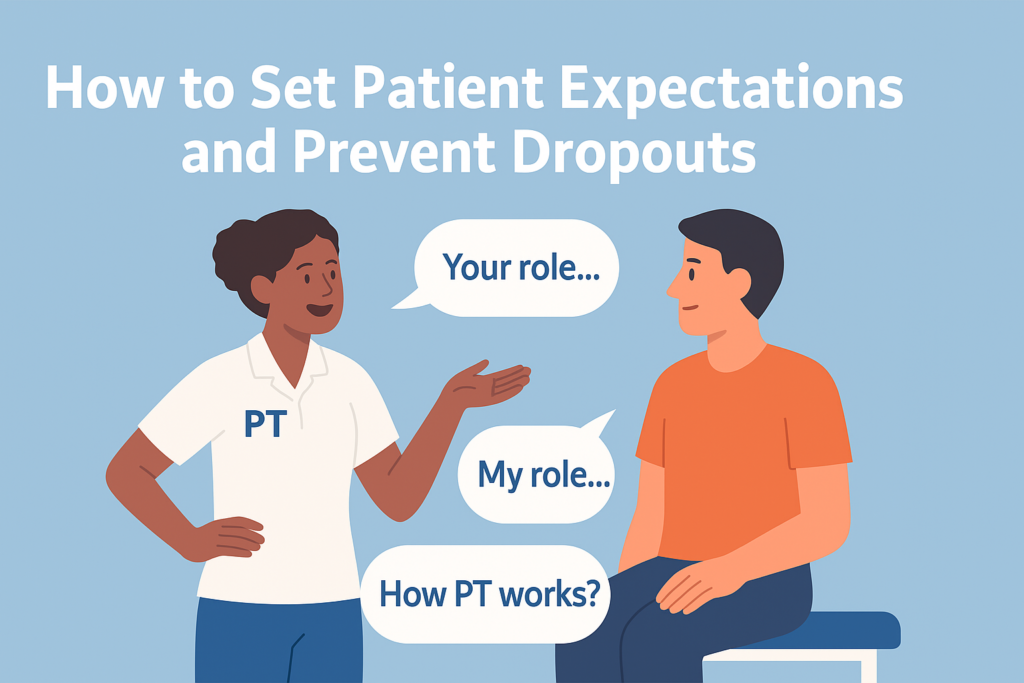Patient Engagement
Clayton W.
How to Set Clear Expectations and Reduce Patient Dropouts in Physical Therapy
Why your patients might be leaving early, and how to stop it before it starts. Most patients don’t quit physical therapy because they’re lazy. They quit because it wasn’t what they signed up for. They show up unsure of what to expect. They assume they’re getting hands-on relief or a quick fix. Then they’re told they’ll need to stretch, strengthen, and return multiple times a week, often at a higher cost than expected.
The result? Confusion. Frustration. Dropout.
So before we blame the patient, we need to ask: Did we set the right expectation?
Here’s how to do it right.

Assume the Patient is Starting From Zero
Anthony Coy, PT, DPT, MBA, shared a simple but powerful strategy:
Ask every patient, “Have you been to physical therapy before?”
If they haven’t, that’s your cue to give a quick elevator speech:
- What physical therapy is
- What the patient experience will feel like
- What your role is (and what theirs will be)
Don’t jump into treatment before laying the groundwork. This two-minute conversation can completely shift how the patient engages with care.
Use Analogies to Make the Invisible Visible
Anthony Maritato used a brilliant metaphor in the original post:
“Imagine going to a nice restaurant, only to be handed an apron and told to cook the meal yourself.”
That’s what PT can feel like to a new patient. They expected to be cared for. Instead, they’re asked to do the work.
Use storytelling to connect:
- “PT is like a gym with a coach. You’re not just showing up, you’re participating.”
- “We don’t just treat pain. We teach you how to stay out of pain.”
Set the tone early. Expectations shape experiences.
Ask What They Expect and Hope For
Jimmy McKay, PT, DPT, nailed this:
“I never asked, ‘What do you expect will happen here?’ or ‘What do you hope we’ll do (or not do)?’”
Ask these early:
- “What were you hoping this would help with?”
- “What do you believe is causing the pain?”
- “Have you had PT before? What did you like or not like?”
These questions show empathy, open dialogue, and give you a chance to align their mental picture with reality before frustration takes root.
Reinforce Value Throughout the Plan of Care
Don’t stop after the eval. Patients often forget what you told them by visit three.
Reinforce:
- The purpose behind each session
- How their effort is paying off
- The timeline they can expect for results
Dionne Middlebrooks, PT, DPT, OCS, CSCS, put it well:
“Setting expectations is key. Ask about goals. Reflect internally before blaming the patient.”
If someone starts missing visits or seems disengaged, revisit the “why,” not just the schedule.
Make Expectation-Setting a Team Standard
Expectation-setting shouldn’t just be a provider thing. It should be:
- Part of the intake script
- Baked into automated pre-visit communication
- Reinforced by your front desk and support staff
When every team member is aligned, the patient experience feels cohesive and predictable, not disjointed.
Non-Compliance Is Often Miscommunication
Patients don’t show up confused, frustrated, or disappointed on purpose.
They show up with a different picture of what PT would be, and no one corrected it.
So next time someone drops out early, don’t reach for the label “non-compliant.”
Ask: Did we set the right expectation?
And if not, how can we do better?
Be sure to check out our other post on How to Reduce No-Shows and Cancellations in 6 Simple Steps.
Want to train your team to set better expectations, track drop-offs, and keep patients engaged from day one?
It’s the easiest way to turn insights into action, one patient at a time.
